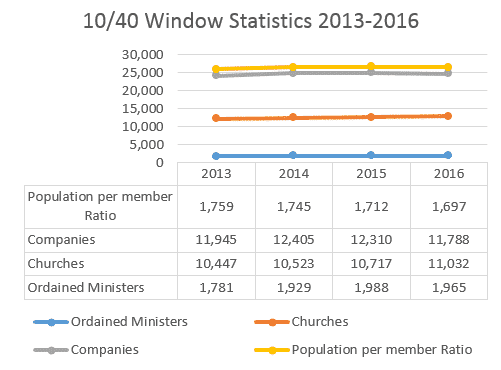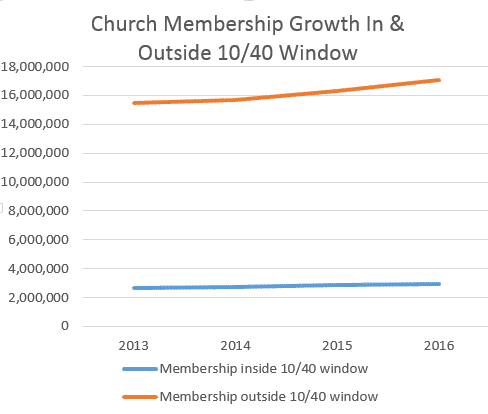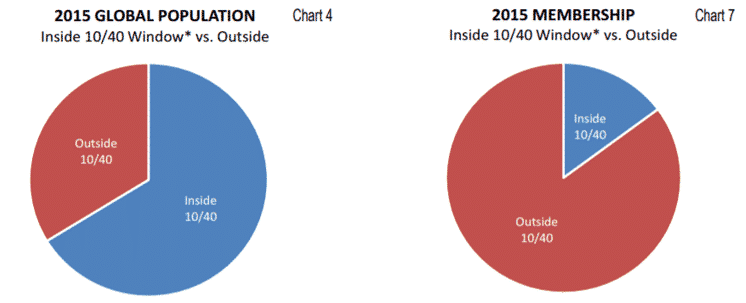And this gospel of the kingdom will be preached in the whole world as a testimony to all nations, and then the end will come.
– Matthew 24:14 (NIV)
As Seventh-day Adventists, we have placed all of our bets on Jesus’s second coming. In preparation, we’ve been charged with preaching the gospel to all nations around the world and, year after year—congregations and church leadership alike—sit down to strategize for ways in which we may fulfill that mission. Given how much attention, talk, and planning go into this effort of reaching the whole world we must ask ourselves—how are we actually doing?
To have a better idea of our progress in this area, we’re going to look at data on Adventist presence in a part of the world that is infamously challenging to reach and least evangelized by Christianity: the 10/40 Window, a region between the 10 and 40 northern lines of latitude in the eastern hemisphere including parts of North Africa, the Middle East, and Asia. These countries face several issues related to religious liberty and poverty as well as the accompanying socioeconomic and cultural problems. This region of the world has been, for over twenty years, an area of priority for the Adventist church. Today, we’re comparing data from the 2017 Annual Statistical Report (2017 ASR) and the 2018 Annual Statistical Report (2018 ASR) (hyperlink it) to see the extent to which Adventists have presence and reach in this region.

For a bit of a wider scope, let’s turn to the ASR data from 2013-2016. As you can see in the table to the left, the number of ordained ministers within the region have not declined drastically, while the numbers of churches within the region have increased by a few hundred. There has been a slow drop in population per member ratio, reflecting the overall growth of population and church membership inside of the 10/40 window, which is certainly encouraging. However, the overall church membership growth inside of the 10/40 Window still lags behind the growth everywhere else in the world (as illustrated in the graph below) which might make sense because majority of SDA membership is outside of this region, even though the 10/40 window includes some of the most highly populated countries in the world.

In fact, the 2017 ASR points out that the great majority of the global population in 2015 lived inside of the 10/40 window, but the reverse is true for SDA church members as illustrated in the graph below.

As noted in the introduction to the 2017 ASR written by ASTR director David Trim, there is a striking dissonance between the distribution of the world’s population and that of Seventh-day Adventist congregations, ministers, and members. Another way we might look at this information is in terms of how many SDA church members we have per 10,000 people: in 2015, there were 5.84 members per 10,000 people within the 10/40 window while outside of the 10/40 window we had 65.72:10,000—the ratio of Adventists to population is 11 times better outside of the 10/40 region than it is inside.
The Seventh-day Adventist Church is committed to improving the quality of life in this region of the world through education, health, and other services. From the 2018 ASR data we know that the SDA church has 33 hospitals, 350 medical/dental clinics and airbases, 5 nursing homes/retirement centers, 23 tertiary schools, and 116 secondary schools in the region. Yet due to the existing challenges in what is home to some of the poorest countries in the world, in the 10/40 window we have two times less hospitals, six times less orphanages, 15 times less nursing or retirement centers, and 3.5 times less tertiary schools with more than 5 times less secondary schools than those we operate outside of the region.
These numbers are striking and encourage us to ask ourselves—how do we improve our strategies for reaching out to the 10/40 window? In a previous blog we analyzed one such global outreach strategy formulated by the Global Mission Centers of the General Conference Office of Adventist Mission: you can read more about it here. Global outreach strategies, however, are often far removed from the individual lay member who may struggle to find ways in which to contribute to them. Thankfully there is much we can do for the 10/40 window from the comfort of our home church pews. This is one of the reasons that it is important for us to educate ourselves on and contribute to world mission projects (as we detailed in the last blog, which you can read here) so that we may dutifully and prayerfully hasten the second coming of Jesus.
To read more about the challenges the SDA church is facing in the 10/40 window visit: https://am.adventistmission.org/mission-challenges
You can find all of the ASRs mentioned above (and more) here.

